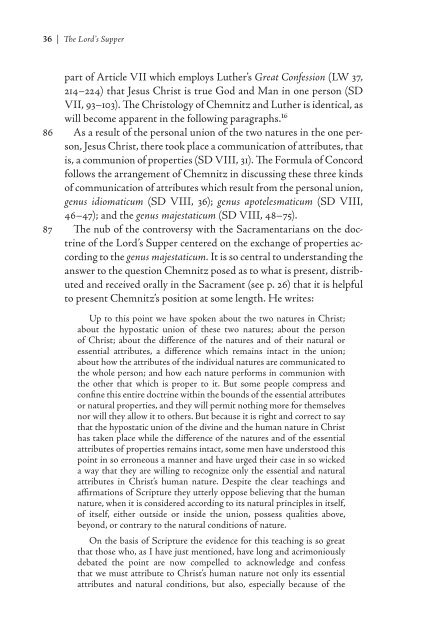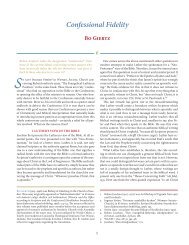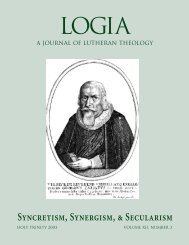The Lord's Supper in the Theology of Martin Chemnitz Bjarne - Logia
The Lord's Supper in the Theology of Martin Chemnitz Bjarne - Logia
The Lord's Supper in the Theology of Martin Chemnitz Bjarne - Logia
You also want an ePaper? Increase the reach of your titles
YUMPU automatically turns print PDFs into web optimized ePapers that Google loves.
| <strong>The</strong> Lord’s <strong>Supper</strong><br />
part <strong>of</strong> Article VII which employs Lu<strong>the</strong>r’s Great Confession (LW 37,<br />
214–224) that Jesus Christ is true God and Man <strong>in</strong> one person (SD<br />
VII, 93–103). <strong>The</strong> Christology <strong>of</strong> <strong>Chemnitz</strong> and Lu<strong>the</strong>r is identical, as<br />
will become apparent <strong>in</strong> <strong>the</strong> follow<strong>in</strong>g paragraphs. 16<br />
86 As a result <strong>of</strong> <strong>the</strong> personal union <strong>of</strong> <strong>the</strong> two natures <strong>in</strong> <strong>the</strong> one person,<br />
Jesus Christ, <strong>the</strong>re took place a communication <strong>of</strong> attributes, that<br />
is, a communion <strong>of</strong> properties (SD VIII, 31). <strong>The</strong> Formula <strong>of</strong> Concord<br />
follows <strong>the</strong> arrangement <strong>of</strong> <strong>Chemnitz</strong> <strong>in</strong> discuss<strong>in</strong>g <strong>the</strong>se three k<strong>in</strong>ds<br />
<strong>of</strong> communication <strong>of</strong> attributes which result from <strong>the</strong> personal union,<br />
genus idiomaticum (SD VIII, 36); genus apotelesmaticum (SD VIII,<br />
46–47); and <strong>the</strong> genus majestaticum (SD VIII, 48–75).<br />
87 <strong>The</strong> nub <strong>of</strong> <strong>the</strong> controversy with <strong>the</strong> Sacramentarians on <strong>the</strong> doctr<strong>in</strong>e<br />
<strong>of</strong> <strong>the</strong> Lord’s <strong>Supper</strong> centered on <strong>the</strong> exchange <strong>of</strong> properties accord<strong>in</strong>g<br />
to <strong>the</strong> genus majestaticum. It is so central to understand<strong>in</strong>g <strong>the</strong><br />
answer to <strong>the</strong> question <strong>Chemnitz</strong> posed as to what is present, distributed<br />
and received orally <strong>in</strong> <strong>the</strong> Sacrament (see p. 26) that it is helpful<br />
to present <strong>Chemnitz</strong>’s position at some length. He writes:<br />
Up to this po<strong>in</strong>t we have spoken about <strong>the</strong> two natures <strong>in</strong> Christ;<br />
about <strong>the</strong> hypostatic union <strong>of</strong> <strong>the</strong>se two natures; about <strong>the</strong> person<br />
<strong>of</strong> Christ; about <strong>the</strong> difference <strong>of</strong> <strong>the</strong> natures and <strong>of</strong> <strong>the</strong>ir natural or<br />
essential attributes, a difference which rema<strong>in</strong>s <strong>in</strong>tact <strong>in</strong> <strong>the</strong> union;<br />
about how <strong>the</strong> attributes <strong>of</strong> <strong>the</strong> <strong>in</strong>dividual natures are communicated to<br />
<strong>the</strong> whole person; and how each nature performs <strong>in</strong> communion with<br />
<strong>the</strong> o<strong>the</strong>r that which is proper to it. But some people compress and<br />
conf<strong>in</strong>e this entire doctr<strong>in</strong>e with<strong>in</strong> <strong>the</strong> bounds <strong>of</strong> <strong>the</strong> essential attributes<br />
or natural properties, and <strong>the</strong>y will permit noth<strong>in</strong>g more for <strong>the</strong>mselves<br />
nor will <strong>the</strong>y allow it to o<strong>the</strong>rs. But because it is right and correct to say<br />
that <strong>the</strong> hypostatic union <strong>of</strong> <strong>the</strong> div<strong>in</strong>e and <strong>the</strong> human nature <strong>in</strong> Christ<br />
has taken place while <strong>the</strong> difference <strong>of</strong> <strong>the</strong> natures and <strong>of</strong> <strong>the</strong> essential<br />
attributes <strong>of</strong> properties rema<strong>in</strong>s <strong>in</strong>tact, some men have understood this<br />
po<strong>in</strong>t <strong>in</strong> so erroneous a manner and have urged <strong>the</strong>ir case <strong>in</strong> so wicked<br />
a way that <strong>the</strong>y are will<strong>in</strong>g to recognize only <strong>the</strong> essential and natural<br />
attributes <strong>in</strong> Christ’s human nature. Despite <strong>the</strong> clear teach<strong>in</strong>gs and<br />
affirmations <strong>of</strong> Scripture <strong>the</strong>y utterly oppose believ<strong>in</strong>g that <strong>the</strong> human<br />
nature, when it is considered accord<strong>in</strong>g to its natural pr<strong>in</strong>ciples <strong>in</strong> itself,<br />
<strong>of</strong> itself, ei<strong>the</strong>r outside or <strong>in</strong>side <strong>the</strong> union, possess qualities above,<br />
beyond, or contrary to <strong>the</strong> natural conditions <strong>of</strong> nature.<br />
On <strong>the</strong> basis <strong>of</strong> Scripture <strong>the</strong> evidence for this teach<strong>in</strong>g is so great<br />
that those who, as I have just mentioned, have long and acrimoniously<br />
debated <strong>the</strong> po<strong>in</strong>t are now compelled to acknowledge and confess<br />
that we must attribute to Christ’s human nature not only its essential<br />
attributes and natural conditions, but also, especially because <strong>of</strong> <strong>the</strong>




